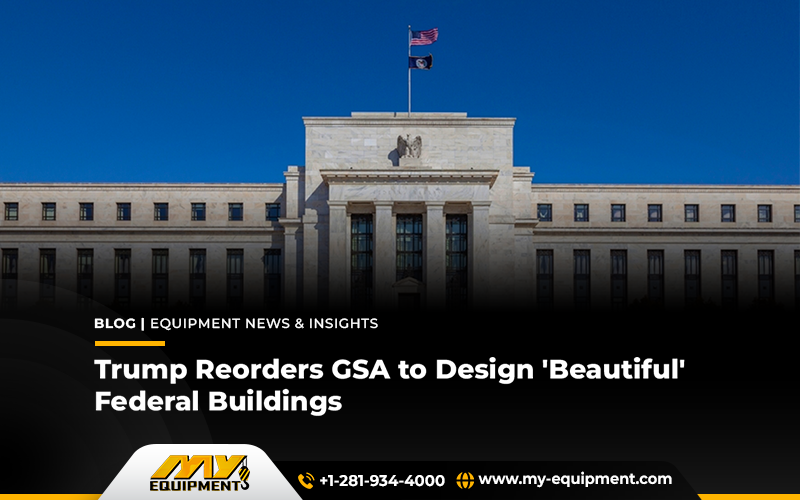Back in 2020, former President Donald Trump chose to make a major decision about how federal buildings throughout the United States should appear. Due to some controversies, the order took a laid-back which has missed the order for a long.
Now after his re-election in 2025, he reorders the General Services Administration (GSA) to construct all new government buildings with “beautiful” classical architectural elements. The real definition behind this statement remains unclear. What motivated Trump to introduce this architectural policy change?
What is Classical Architecture?
The architectural tradition known as Classical design comes from the building styles of ancient Roman and Greek cultures. The architectural elements that define classical design include columns alongside domes and magnificent elegant structures. Modern architectural leaders would find classical design principles defining the U.S. Capitol and the White House. Under Trump’s order builders must use traditional architectural elements rather than modern minimalist approaches for new federal buildings.
Why Did Trump Want This?
Throughout his entire life, Trump has demonstrated passionate support for classical architectural designs. He recognizes classical styles as perpetually beautiful structures that also transmit powerful messages about national pride and stability. The president requested during his time in office that federal structures showcase “beauty” together with “a sense of permanence” which he felt contemporary designs including glass and steel skyscrapers were unable to achieve.
The directive existed as a component of Trump’s wide-ranging initiative to promote American traditions together with cultural heritage and national identity. According to Trump classical architecture established strong visual ties between public buildings and national values which produced grander treasured government facilities.
The Role of the GSA
Federal agency responsibility for managing construction projects and maintaining federal buildings exists within the General Services Administration. The executive order from Trump required the GSA to develop new building standards for all their government construction work. These guidelines included:
Favoring classical designs
Modern building designs must incorporate classical architectural elements because such elements deliver enduring elegance together with balancing features. Columns deliver both enhanced load-bearing capability and spectacular visual impacts to support structural integrity along with symmetrical layouts that present balanced proportions. The durability of these architectural components demonstrates both their functional and visual benefits. New constructions that include these elements establish connections between past and present while protecting their cultural heritage and architectural value.
Aesthetic focus
The construction of lasting buildings needed architects to create structures that combined attractive visual designs with durable structural stability. Designers needed to match attractive appearances with structural durability to achieve buildings that combined aesthetics with longevity and functional safety.
No more modernist trends
According to the order, architects lost the ability to create modern buildings with clean lines and reduced ornamentation which constitutes contemporary architectural designs. The architectural rules forced designers to use traditional elements with symmetrical features found in classical designs.
The Controversy
The push for classical architecture Trump received resistance from multiple sources. Critics together with some architects maintained that this design approach presented a restrictive method that elevated project and heavy equipment expenses. These critics maintained that government buildings need to demonstrate multiple architectural designs that meet today’s societal requirements while being sustainable and energy-efficient.
Many believed classical design requirements imposed upon architects reduced their freedom which caused federal buildings to lose their connection with modern design standards. Several critics expressed concern that design emphasis might lead to a neglect of functional priorities such as building access and sustainability measures.
What’s Happening Now?
Presently the extent of impact from Trump’s order on federal building construction remains uncertain. The Biden administration’s 2021 inauguration creates possibilities for revising or canceling the federal building design policy that Trump introduced. This directive potentially continues to affect ongoing projects under development.
But one thing is clear, the executive order from Trump initiated a national discussion about the architectural type that should symbolize our government. The discussion surrounding public buildings persists regarding design approaches since citizens disagree about their appearance and what architectural choices signify about national values.
The Direction of Federal Building Design Moves Forward
Federal architecture faces an unstable future direction because of Trump’s executive order. Public reception together with societal value transformations will shape most future choices about public building designs and existing structure renovations. The argument between traditional and modern building design approaches for public facilities will persist indefinitely because the next generations’ political institutions will continue to participate in this debate.
Overview
The discourse across America continues to heat up following President Donald Trump’s executive order to require classical architectural style in new federal construction. The Trump executive order champions classical architecture but casts uncertainty on emerging creativity while potentially increasing project costs and reducing opportunities for contemporary approaches in design. The features of adaptable designs and sustainable elements and performance techniques in modern buildings worry critics who believe classical design requirements would eliminate these advantages. Designers who focus on exterior aesthetics create design restrictions that block essential factors such as accessibility and sustainability from influencing their work.


 1400 Broadfield Blvd, Houston, TX 77084,
USA.
1400 Broadfield Blvd, Houston, TX 77084,
USA.